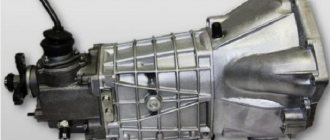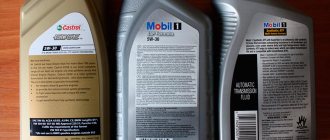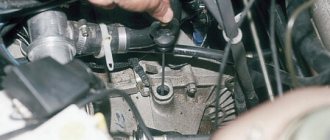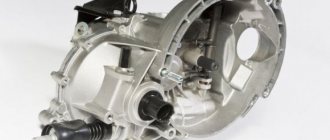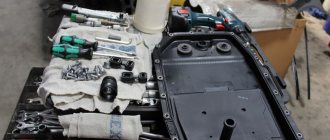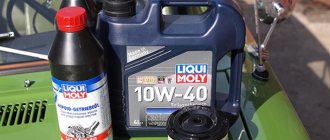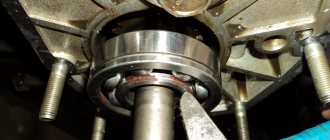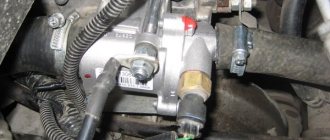When is it necessary to change the oil in an automatic transmission?
Some car manufacturers position automatic transmissions in their models as maintenance-free. This means that the replacement of technical transmission fluid is not provided for according to the regulations and the box will last 150 thousand km, after which it will require a major overhaul, during which new oil will be filled. But from service practice it is clear that changing the oil in an automatic transmission after 50-80 thousand km extends the life of the unit to 200,000-250,000 km.
Condition of the technical fluid if it is not changed
Other car manufacturers directly indicate in the operating instructions that the transmission fluid needs to be changed every 60 thousand km. The following signs while driving may indicate the need for an unscheduled replacement:
- the box “kicks” when switching;
- there are significant delays when changing to an upshift or downshift;
- extraneous noise is heard from the automatic transmission (howling, knocking, humming);
- It is impossible to engage reverse gear.
To further determine the condition of the oil, you will need diagnostics to check its level and temperature, as well as the pressure in the box. The level is marked by a dipstick or control hole, and other parameters are indicated by special instruments.
If the color of the lubricant is dark, opaque and gives off a burning smell (friction discs burn), then an unscheduled oil change in the automatic transmission will be required, regardless of the distance traveled.
If you continue to operate with the old ATF fluid, the existing chips in the sump can get stuck in the valve body channels and damage the torque converter. This will disrupt the operation of the automatic transmission and the box will go into emergency mode. You will be able to continue driving only at low speed, or you will even have to call a tow truck. Overhauling an automatic transmission will require a lot of money. Alternatively, you will have to replace the complete unit. It is better not to let the car get into this state and perform maintenance on time.
How often does it need replacement?
When manufacturing automobiles, the manufacturer specifies maintenance requirements for each brand. This information can be found in the machine manual. It indicates the period for replacing the lubricant in the box.
Today, you can find technical documentation for any car model on the World Wide Web. It defines the exact mileage or time period at which you need to change the oil in the manual transmission. But there are average values for any car when it is necessary to change the lubricant according to the regulations. In terms of time, this should be done every 5 years or 100 thousand km.
Often, for Russian cars produced before 2000, according to documents, the oil change period is specified after a mileage of 200 thousand km. But modern cars of Russian or foreign manufacture have the same recommendations for their entire service life. This means that the car must be disposed of after the expiration date. But no one does this; they try to sell her. Therefore, in order for the car to continue to drive, the lubricant in the gearbox needs to be changed more often.
When to change the oil?
Generally accepted recommendations are every 80,000 km or every 5 years. If operating conditions are severe - after 50,000 km.
Sometimes you have to change the lubricant deviating from the regulations. This is done in the following cases:
- Buying a car. Replacement is necessary because there is no guarantee that maintenance was carried out on time.
- Replacing the manual transmission. It is better to fill the new unit with fresh oil. But, if in the old unit it was changed according to the regulations, then in the new one the lubricant can be reused.
- Box repair. After overhauling the unit, only fresh lubricant is used.
- Noise or jerking when changing gears. To eliminate these causes, you can first change the oil and then try to repair it.
Preparation
You can change the oil at a service station or do it yourself. To change the oil in an automatic transmission yourself, you will need an inspection hole or overpass. You can ask a friend to go to his garage. Overpasses are often located near garage cooperatives, where a security guard will allow you to use it for a small fee.
Changing the oil in an automatic transmission involves removing the pan and filter. Some people wash the old filter in gasoline or kerosene and reuse it, but this should not be done.
Reduced filter capacity can lead to problems with the box. You can choose the right new filter based on the year of manufacture and make of the car. The manufacturer’s website also contains information about the automatic transmission itself (series, number), which will make the task easier (some Japanese or German-made gearboxes are installed on different brands of cars, so you can find a filter that suits your automatic transmission, although it is intended for a different car).
Need a new filter and gasket
In preparation, purchase a pan gasket. Surely the old one is already roughened or has cracks. When dismantling the pallet, it often breaks. A new gasket will ensure the seal of the housing and eliminate the leakage of ATP fluid, leading to a drop in the level. The drain plug has a copper washer, which often becomes deformed and worn off during operation. You also need to buy it to replace it. On the official website of the car manufacturer there are recommendations on which oil according to SAE viscosity to pour into the box and in what volume. Also take care of the keys for unscrewing the pan plug, dismantling the filter, removing the pan itself and the automatic transmission radiator pipes (the latter is needed if the complete replacement method is chosen).
Useful tips
Before starting to operate the vehicle, it is recommended to carry out a visual inspection of the vehicle and the parking area. If drips and oil stains are found on the floor under the bottom, you need to check the oil level in the manual transmission. Even a small decrease in oil volume can lead to intense wear of the gears, followed by serious repairs to the transmission and the vehicle as a whole.
One of the basic rules for changing oils and operating manual transmissions is that timely installation of new gaskets and oil seals instead of worn ones can help eliminate oil loss, and also prevent breakdowns and wear of gears.
Each car shows different results for the oil filled. For some, only synthetics are needed, while others work fine with cheap mineral water. Most often, drivers choose the golden mean: semi-synthetics. The most important condition is maintaining stability of operation, as well as the technical and operational characteristics of the vehicle over a long period.
How to drain oil from an automatic transmission
The main difficulty when changing ATF fluid in an automatic transmission is draining the waste. Unlike a manual transmission, there is a complex hydraulic unit with a torque converter, containing many narrow channels inside for oil circulation.
With most methods, it will be possible to drain the waste only partially, and only a complete hardware replacement will remove the old transmission fluid without any residue.
But, regardless of the chosen method, you will need to drain the waste from the pan. Let's consider the procedure and existing options.
Popular brands:
Hyundai Santa Fe, Mitsubishi Pajero, Skoda Octavia
Draining oil through the plug
The easiest way. If your car has a drain plug on the automatic transmission housing, then:
- Drive the car 5 km to warm up the engine and transmission.
- Place the car on a pit, overpass or lift.
- Prepare a bucket or cut canister with a capacity of at least 5 liters.
- Unscrew the drain plug with a wrench (usually a tetrahedron). Unscrew it further with your hands, holding it from the side and not from the bottom.
- Abruptly remove your hand with the stopper, exposing the container.
- When the waste has finished dripping, the old oil is considered almost drained - you will also need to dismantle the pan and filter.
Draining used oil through the drain hole
Draining oil through the dipstick
There are cars where the drain plug is not provided. Changing the oil in an automatic transmission is possible here by pumping out the old ATP through a channel with a dipstick. To do this, use a transparent tube from a dropper, purchased at a pharmacy. Remove the dipstick and insert the tube in its place. Lower it to the very bottom of the tray. Attach the free end from the outside to the syringe. The larger the capacity of the latter, the better.
Pumping out oil with a syringe
By extending the rod, a vacuum is created and ATF is pumped out of the pan. You need to act measuredly, since the mining is thick and moves slowly. To pump out 4 liters the process will need to be repeated about 30 times. To make the procedure easier, third-party manufacturers have developed a vacuum pump. It connects to the battery terminals and pumps old ATP from the sump through the dipstick hole into a substitute container. Everything happens quickly and easily, but you will have to spend money on equipment.
Pumping out used oil with a pump
Removing the box tray
Another way to change the oil in an automatic transmission is to remove the old one by immediately removing the pan with the filter. It's a dirty job, but it saves time. The heated car is placed on the pit and the bolts holding the automatic transmission pan are unscrewed. You will need to install a large basin at the bottom of the hole. First, a gap is created on one side of the body and the waste is drained from it. When it does not drip, the bolts are completely unscrewed and the pan with the remaining liquid is set aside. It contains a filter and a magnet that accumulates chips. The magnet is washed and the filter is replaced with a new one. Changing the oil in an automatic transmission is easier this way, since you don’t need to bother with a syringe and tube or buy a vacuum pump, but it’s impossible not to get dirty.
Removing the pan and filter
Oil change methods
Let's look at how to correctly change the oil in an automatic transmission, partially or completely, in what order the actions are performed and where to fill in the new fluid. Understanding the peculiarities of the process, it will be easier to decide whether to do the work yourself or contact a car service.
Partial oil change in automatic transmission: instructions
Modern automatic transmissions contain 6-8 liters of ATF, depending on the make and model. Partial replacement is considered a “refreshment” of the composition, since with this method it is possible to add only 30-40% of new transmission fluid. It's more affordable than a full replacement and takes about 60 minutes. But the effect does not last long - the procedure must be repeated every 15-20 thousand km.
Let's look at the procedure for changing the oil in an automatic transmission in step-by-step instructions:
- The engine starts and the car is driven for 10-20 minutes so that the internal combustion engine and gearbox reach operating temperature. This will help increase the fluidity of the lubricant.
- The car drives into a pit.
- The underbody protection is removed.
- Use a square wrench to unscrew the plug in the pan.
- Place a container and drain the old grease.
- The pan is dismantled and the old filter is removed from it. The magnet is cleaned.
- A new filter and gasket are installed. The pallet returns to its place.
- New ATF fluid is poured through the dipstick hole or breather to maintain atmospheric pressure. The level is set between the minimum and maximum marks.
After removal, the tray needs to be cleaned
Recommendations for car enthusiasts. To set the level correctly, you need to “drive” the box through all gears. This will fill the couplings with ATP fluid and expel the air.
The advantages of this method: you can do everything yourself, it will take 1 hour, a volume of 3-4 liters of transmission fluid for an automatic transmission is inexpensive. The disadvantages include: the need to repeat the process after 15,000 km, there may be delays during switching, hum, the life of the box is extended, but only slightly.
Conclusion
For those vehicle owners who want to extend the smooth operation of their car, timely oil changes are an important procedure. Each driver must monitor the operation of all components of the car, which is impossible without monitoring all working fluids. It is much easier to top up or change the oil in a manual transmission on time than to deal with expensive repairs later. If it is not possible to turn to specialists, then this not at all difficult work can be done with high quality and yourself.
Complete automatic transmission oil change: instructions
It is possible to completely replace the transmission fluid, but this is a more expensive process. But it gives a significant improvement in the operation of the box. Let's look at how ATP changes using hardware and manual methods to choose the appropriate option.
Method No. 1
This method is suitable for self-replacement in a garage with a pit. Everything is done as in the situation described above: the old lubricant is drained, the pan is cleaned, a new filter and gasket are installed, and fresh ATP is filled in according to the level. After driving about 200 km in normal operation, the procedure is repeated (the filter and gasket no longer need to be changed, but only washed and cleaned).
Since when draining by gravity or sucking with a syringe, it is possible to extract about 40% of the lubricant from the automatic transmission, adding fresh transmission fluid to the level only dilutes the composition. At the first change, the ratio of new and old oil in the box is 40/60%. When replacing again - approximately 70/30%. With the third - 85-90/15-10%. Replacements are not performed more than three times in a row - it is not financially feasible.
The advantages of the method include:
- the ability to do everything yourself in a garage;
- no expensive equipment required;
- You only need to pay for ATP (the filter and pan seal are purchased once for the first replacement).
But this method is time-consuming - every 200 km you will have to remove the underbody protection, drain the used lubricant, and fill in new one. Not everyone has the time to do this type of maintenance every week. 100% replacement is not possible. Therefore, let's consider other methods.
Method No. 2
A complete automatic transmission oil change with your own hands is possible if you use the pressure in the box to pump out waste. To do this, all actions are performed as in the case of a partial replacement (draining, replacing the filter and cleaning the pan). Then fresh ATF is poured into the box to the very top (until it flows out of the filler hole). The supply and return lines are disconnected from the transmission cooling radiator and the ends of the hose are lowered into a container (12 liter basin, bucket, etc.).
Connection diagram of the automatic transmission to the cooling radiator
The engine starts and the pressure in the box begins to build up and the transmission fluid begins to circulate. With this method, waste is forced out of the torque converter and valve body naturally. When about 4 liters have drained, turn off the engine and add more fresh ATP. The engine starts again and the system continues to bleed. Noticing the light color of the lubricant at the output, the process stops. All that remains is to attach the hoses to the radiator pipes, set the level and drive the car in different modes for the test.
With this method, natural circulation in the unit is used to pump the system without the help of additional equipment. You will only have to pay for consumables and the volume of technical fluid - 7-9 liters. The entire procedure is carried out in one go - there is no need to perform repairs every week. But there are also disadvantages: the operation is quite complicated and scary for a beginner - you can do something wrong and damage the node.
The most common mistake is the ATF level in the pan being too low, which leads to air being sucked in and running dry.
This can damage the clutch pack, planetary gear or torque converter. Repairs will be expensive.
Method No. 3
The most effective way is hardware replacement. This is the displacement of old lubricant by pumping new lubricant through the system under pressure from a special station. The automatic transmission oil change scheme using modern equipment looks like this:
- The car is driven onto a lift, where the protection is dismantled and the waste is drained.
- The pan is removed, cleaned and a new gasket with filter is installed. Everything returns to its place.
- The supply and return pipes of the radiator of the box are unscrewed.
- They are connected to hoses from the station, which is already filled with 10-12 liters of new ATP.
- The engine starts and the device begins to supply fresh transmission fluid to the box. The hydraulic unit pumps it and it comes out through the pipe, but instead of the radiator it ends up outside and drains into a receiving container.
- Through the transparent tube you can see what color the liquid is. When it becomes identical to the new lubricant, the process is stopped and the level is set.
Hardware oil change in automatic transmission
The good thing about this method is that it provides 100% replacement through displacement. The torque converter and valve body are washed. The quality of service can be seen immediately by the color of the lubricant pouring out. Transmission performance improves: it becomes quieter, shifts faster, and the ride becomes smoother. Drivers note a reduction in fuel consumption. But there are also disadvantages: you will need a large volume of 11-12 liters of transmission fluid, half of which is spent simply on flushing. The replacement device is expensive and not available in every service station, not to mention garage workshops. In some unscrupulous car service centers, they may take 12 liters of technical fluid, but fill only 6 liters, appropriating the rest for themselves. Sometimes they forget to install a filter or replace the gasket.
Recommendations for car enthusiasts. To check the quality of a complete replacement, ask to be present during the service - normal service stations will not refuse this. Also drop a little ATF from the dipstick onto the paper - the new one will be red, and the old one will be black or cloudy.
avtoexperts.ru
If a car enthusiast does not like to delve into the insides of the car or does not have enough experience, we recommend changing the gearbox oil at a service station. Below we will look at ways to independently replace transmission fluids for manual and automatic transmissions.
Algorithm for a complete oil change in a manual transmission:
- We warm up the oil in the gearbox by driving the car for 5-10 km, so that it turns from thick to liquid, suitable for draining;
- We install the car on a lift or inspection hole. Parking the machine to drain the transmission fluid must be done no later than 10-15 minutes after stopping the engine, otherwise the oil will thicken again;
- Remove the engine crankcase protection (if equipped). We unscrew the control hole plug, through which you can measure the transmission fluid level. At the same time, we check whether the gasket on this cover needs to be changed. If the car has a high mileage or it has been used in difficult conditions, then this gasket (O-ring) has probably worn out and will require replacement;
- Open the drain hole located in the gearbox housing and drain the oil into a prepared container (you can use an old motor oil canister with a funnel in its neck). When the transmission fluid has drained, screw on the drain cap;
The filler hole is yellow, the drain hole is white using the example of Ford Fiesta 1.4
- Using a Janet medical syringe, draw up new oil and pour it into the oil filler neck. Important: the transmission fluid fill level should not be higher than the lower edge of the inspection hole neck. If oil begins to drip from this hole, stop filling.
Fill the gearbox with oil through a syringe
- Screw on the oil filler cap. Reinstall the crankcase protection. We start the engine and drive several kilometers at different speed levels, allowing the new oil to fill the gearbox mechanisms. We check the transmission fluid level and, if necessary, add the required amount.
Algorithm for completely replacing transmission fluid in an automatic transmission:
- Preparatory stage - warming up the fluid in the box when driving 5-10 km, installing the car on a viewing hole/lift, removing the crankcase protection;
- We place a container under the lower part of the gearbox (the volume of the container is at least 5 liters), unscrew the plug on the automatic transmission pan, and drain the working transmission fluid;
- We unscrew the fastenings of the automatic transmission filter, remove the hydraulic unit, drain the remaining oil from these parts;
- To drain the fluid faster, move the automatic transmission selector with the engine turned off to the positions from Parking to Drive and back. It is recommended to repeat these steps 2-3 times. Then we carry out the same operation with the engine running - this is sometimes done to completely remove the remaining waste fluid from the box.
Important
: engine operating time when draining used ATF is no more than 1 minute. The longer the engine runs, the greater the likelihood that the pump driving fluid through the gearbox may break down;
- If the filter cells are moderately dirty, it can be washed with gasoline or white spirit, then dried and replaced. If the filter is very dirty, we recommend installing a new filter element. Then we mount the hydraulic unit with the new filter in place;
- We install the automatic transmission pan in place, having first replaced its gasket;
- Through the oil filler hole, which is located in the engine compartment, after removing the dipstick, using a Janet syringe or a watering can with a special nozzle, pour in 3-4 liters of transmission fluid;
- We start the car engine and move the automatic transmission lever to the positions from Parking to Drive and back. This is necessary to run the new ATF through all gearbox components;
- We check the transmission fluid level using a dipstick (its volume for each individual gearbox can be found in the vehicle’s operating manual). This must be done with the engine running and the automatic transmission knob in neutral. If necessary, add a liter of oil and warm up the machine engine to operating temperature. Measure the oil level in the automatic transmission again.
Important
: there are two marks on the dipstick - Cold (oil level for “cold”) and Hot (fluid level for “hot”). The gearbox is considered to be fully filled with transmission fluid when its level reaches the maximum Hot mark.
- We install the dipstick in place. The transmission fluid has been completely replaced.
Replacement at a service station
Service stations practice partial replacement and complete renewal of the composition of the ATP transmission fluid, which is chosen by the client himself. As a rule, high-quality lubricants of different viscosities are already available, so you only need to bring a filter to your car model. But some services also have consumables for popular car brands in stock in order to save car owners’ time as much as possible.
If the client chooses the partial method, then the waste is removed through the drain hole (if provided by the car manufacturer) or pumped out through the dipstick.
When completely updating the composition with washing, modern equipment is used. They are universal and suitable for all car models. Some are equipped with very simple controls with start and stop buttons. The quality of washing is determined by a fragment of a transparent tube attached to the front panel of the stand.
Other versions of service equipment are equipped with a screen and programs for each make and model of car. They are programmed with the volume of lubricant and other operating parameters that ensure the highest quality replacement of the technical fluid in the box. Bench displacement is considered the best today for servicing automatic transmissions. With it, the resource of the node is extended to 200-250 thousand km. The procedure takes 2-3 hours, but it will need to be done once every 50,000-60,000 km.
How to add oil to an automatic transmission
You can add fresh ATP fluid during a partial change or to achieve the desired mark after a complete update in several ways, depending on the design features of the automatic transmission.
Fill the oil through the dipstick
The simplest method, since most cars with automatic transmission have a dipstick. You will need a flexible hose from a medical IV and a funnel attached to its other end. All actions are performed from above in the engine compartment.
Through the breather
The pressure control valve can also be used to supply fluid to the automatic transmission. You will need a flexible hose with a diameter of 8-10 mm and a funnel. You won't be able to fill it directly because wires and other parts in the engine compartment get in the way.
Automatic transmission breather
Pumping oil from below through the control
There is a bolt on the side of the automatic transmission housing that plugs the inspection hole. This is one way to set the level in models without a dipstick. After unscrewing it, ATF fluid is supplied through the hose with a large syringe. Work is carried out from below from the inspection hole.
Changing the oil in the automatic transmission extends the life of the key component of the car. If there is no time and money, a partial update of the composition is performed. But it is better to perform a hardware shake with flushing to avoid costly repairs of the automatic transmission in the future.
Draining oil through the plug
Let's merge! If your box has a drain plug at the bottom, first place some large container under it. Usually, its role is played by cut-off plastic canisters, taking into account that several liters of fluid will come out of the transmission (about 3 to 5). Next, unscrew this drain plug and oil will flow out of the neck by gravity. And now you just have to wait until all the liquid that can leak out, accordingly, flows out. After this, screw the drain plug back on. Count the amount of oil drained from the transmission - you will now need to pour the same amount of new fluid inside.
Changing the oil in a Nissan automatic transmission
